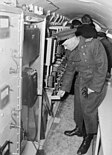BESSY

The Berliner Elektronenspeicherring-Gesellschaft für Synchrotronstrahlung m. b. H. (English: Berlin Electron Storage Ring Society for Synchrotron Radiation), abbreviated BESSY, is a research establishment in the Adlershof district of Berlin. Founded on 5 March 1979, it currently operates one of Germany's 3rd generation synchrotron radiation facilities, BESSY II. Originally part of the Leibniz Association, BESSY now belongs to the Helmholtz-Zentrum Berlin (since 1 January 2009). Owing to the radiometry lab of the PTB [1], BESSY is the European calibration standard for electromagnetic radiation.BESSY supplies synchrotron light and provides support for science and industry. There are institutional long-time users, like the Max-Planck-Society, the German Federal Institute for Materials Research and Testing (BAM) and the national metrology institute of Germany (the PTB). Furthermore, research groups from other institutes or universities can apply for utilization (so called beam time) for certain projects.
Excerpt from the Wikipedia article BESSY (License: CC BY-SA 3.0, Authors, Images).BESSY
Landeskalibrierstrecke Berlin, Berlin Adlershof
Geographical coordinates (GPS) Address Website Nearby Places Show on map
Geographical coordinates (GPS)
| Latitude | Longitude |
|---|---|
| N 52.427777777778 ° | E 13.5325 ° |
Address
Berliner Elektronenspeicherring
Landeskalibrierstrecke Berlin
12489 Berlin, Adlershof
Germany
Open on Google Maps











